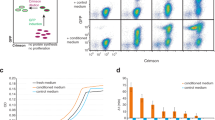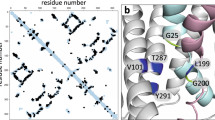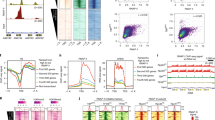Abstract
Bacteria can exist in metabolically inactive states that allow them to survive conditions that are not conducive for growth. Such dormant cells may sense when conditions have improved and re-initiate growth, lest they be outcompeted by their neighbours. Growing bacteria turn over and release large quantities of their cell walls into the environment. Drawing from recent work on the germination of Bacillus subtilis spores, we propose that many microorganisms exit dormancy in response to cell wall muropeptides.
This is a preview of subscription content, access via your institution
Access options
Subscribe to this journal
Receive 12 print issues and online access
$209.00 per year
only $17.42 per issue
Buy this article
- Purchase on Springer Link
- Instant access to full article PDF
Prices may be subject to local taxes which are calculated during checkout



Similar content being viewed by others
References
Oliver, J. D. Recent findings on the viable but nonculturable state in pathogenic bacteria. FEMS Microbiol. Rev. 34, 415–425 (2010).
Jones, S. E. & Lennon, J. T. Dormancy contributes to the maintenance of microbial diversity. Proc. Natl Acad. Sci. USA 107, 5881–5886 (2010).
Gilbert, P., Collier, P. J. & Brown, M. R. Influence of growth rate on susceptibility to antimicrobial agents: biofilms, cell cycle, dormancy, and stringent response. Antimicrob. Agents Chemother. 34, 1865–1868 (1990).
Domingue, G.J. Sr & Woody, H. B. Bacterial persistence and expression of disease. Clin. Microbiol. Rev. 10, 320–344 (1997).
Oliver, J. D. The viable but nonculturable state in bacteria. J. Microbiol. 43, 93–100 (2005).
Stephenson, K. & Lewis, R. J. Molecular insights into the initiation of sporulation in Gram-positive bacteria: new technologies for an old phenomenon. FEMS Microbiol. Rev. 29, 281–301 (2005).
Barry, C. E. 3rd et al. The spectrum of latent tuberculosis: rethinking the biology and intervention strategies. Nature Rev. Microbiol. 7, 845–855 (2009).
Keep, N. H., Ward, J. M., Cohen-Gonsaud, M. & Henderson, B. Wake up! Peptidoglycan lysis and bacterial non-growth states. Trends Microbiol. 14, 271–276 (2006).
Hoare, A., Timms, P., Bavoil, P. M. & Wilson, D. P. Spatial constraints within the chlamydial host cell inclusion predict interrupted development and persistence. BMC Microbiol. 8, 5 (2008).
Roszak, D. B. & Colwell, R. R. Survival strategies of bacteria in the natural environment. Microbiol. Rev. 51, 365–379 (1987).
Bunker, S. T., Bates, T. C. & Oliver, J. D. Effects of temperature on detection of plasmid or chromosomally encoded gfp- and lux-labeled Pseudomonas fluorescens in soil. Environ. Biosafety Res. 3, 83–90 (2004).
Oliver, J. D., Hite, F., McDougald, D., Andon, N. L. & Simpson, L. M. Entry into, and resuscitation from, the viable but nonculturable state by Vibrio vulnificus in an estuarine environment. Appl. Environ. Microbiol. 61, 2624–2630 (1995).
Votyakova, T. V., Kaprelyants, A. S. & Kell, D. B. Influence of viable cells on the resuscitation of dormant cells in Micrococcus luteus cultures held in an extended stationary phase: the population effect. Appl. Environ. Microbiol. 60, 3284–3291 (1994).
Kaprelyants, A. S. & Kell, D. B. Do bacteria need to communicate with each other for growth? Trends Microbiol. 4, 237–242 (1996).
Shah, I. M., Laaberki, M. H., Popham, D. L. & Dworkin, J. A eukaryotic-like Ser/Thr kinase signals bacteria to exit dormancy in response to peptidoglycan fragments. Cell 135, 486–496 (2008).
Sunde, E. P., Setlow, P., Hederstedt, L. & Halle, B. The physical state of water in bacterial spores. Proc. Natl Acad. Sci. USA 106, 19334–19339 (2009).
Cowan, A. E. et al. Lipids in the inner membrane of dormant spores of Bacillus species are largely immobile. Proc. Natl Acad. Sci. USA 101, 7733–7738 (2004).
Setlow, P. I will survive: DNA protection in bacterial spores. Trends Microbiol. 15, 172–180 (2007).
Ghosh, J. et al. Sporulation in mycobacteria. Proc. Natl Acad. Sci. USA 106, 10781–10786 (2009).
Traag, B. A. et al. Do mycobacteria produce endospores? Proc. Natl Acad. Sci. USA 107, 878–881 (2010).
Abdelrahman, Y. M. & Belland, R. J. The chlamydial developmental cycle. FEMS Microbiol. Rev. 29, 949–959 (2005).
Hogan, R. J., Mathews, S. A., Mukhopadhyay, S., Summersgill, J. T. & Timms, P. Chlamydial persistence: beyond the biphasic paradigm. Infect. Immun. 72, 1843–1855 (2004).
Harper, A., Pogson, C. I., Jones, M. L. & Pearce, J. H. Chlamydial development is adversely affected by minor changes in amino acid supply, blood plasma amino acid levels, and glucose deprivation. Infect. Immun. 68, 1457–1464 (2000).
McCaul, T. F. & Williams, J. C. Developmental cycle of Coxiella burnetii: structure and morphogenesis of vegetative and sporogenic differentiations. J. Bacteriol. 147, 1063–1076 (1981).
Omsland, A. et al. Host cell-free growth of the Q fever bacterium Coxiella burnetii. Proc. Natl Acad. Sci. USA 106, 4430–4434 (2009).
Brorson, O. et al. Destruction of spirochete Borrelia burgdorferi round-body propagules (RBs) by the antibiotic tigecycline. Proc. Natl Acad. Sci. USA 106, 18656–18661 (2009).
Kana, B. D. et al. The resuscitation-promoting factors of Mycobacterium tuberculosis are required for virulence and resuscitation from dormancy but are collectively dispensable for growth in vitro. Mol. Microbiol. 67, 672–684 (2008).
Downing, K. J. et al. Mutants of Mycobacterium tuberculosis lacking three of the five rpf-like genes are defective for growth in vivo and for resuscitation in vitro. Infect. Immun. 73, 3038–3043 (2005).
Kana, B. D. & Mizrahi, V. Resuscitation-promoting factors as lytic enzymes for bacterial growth and signaling. FEMS Immunol. Med. Microbiol. 58, 39–50 (2010).
Hayes, C. S. & Low, D. A. Signals of growth regulation in bacteria. Curr. Opin. Microbiol. 12, 667–673 (2009).
Apel, D., White, A. P., Grassl, G. A., Finlay, B. B. & Surette, M. G. Long-term survival of Salmonella enterica serovar Typhimurium reveals an infectious state that is underrepresented on laboratory media containing bile salts. Appl. Environ. Microbiol. 75, 4923–4925 (2009).
Faulkner, G. & Garduno, R. A. Ultrastructural analysis of differentiation in Legionella pneumophila. J. Bacteriol. 184, 7025–7041 (2002).
Steinert, M., Emody, L., Amann, R. & Hacker, J. Resuscitation of viable but nonculturable Legionella pneumophila Philadelphia JR32 by Acanthamoeba castellanii. Appl. Environ. Microbiol. 63, 2047–2053 (1997).
Faulkner, G., Berk, S. G., Garduno, E., Ortiz-Jimenez, M. A. & Garduno, R. A. Passage through Tetrahymena tropicalis triggers a rapid morphological differentiation in Legionella pneumophila. J. Bacteriol. 190, 7728–7738 (2008).
Mukamolova, G. V., Yanopolskaya, N. D., Kell, D. B. & Kaprelyants, A. S. On resuscitation from the dormant state of Micrococcus luteus. Antonie Van Leeuwenhoek 73, 237–243 (1998).
Kell, D. B., Kaprelyants, A. S., Weichart, D. H., Harwood, C. R. & Barer, M. R. Viability and activity in readily culturable bacteria: a review and discussion of the practical issues. Antonie Van Leeuwenhoek 73, 169–187 (1998).
Lewis, K. Persister cells, dormancy and infectious disease. Nature Rev. Microbiol. 5, 48–56 (2007).
Proctor, R. A. et al. Small colony variants: a pathogenic form of bacteria that facilitates persistent and recurrent infections. Nature Rev. Microbiol. 4, 295–305 (2006).
Schumacher, M. A. et al. Molecular mechanisms of HipA-mediated multidrug tolerance and its neutralization by HipB. Science 323, 396–401 (2009).
Balaban, N. Q., Merrin, J., Chait, R., Kowalik, L. & Leibler, S. Bacterial persistence as a phenotypic switch. Science 305, 1622–1625 (2004).
Setlow, P. Spore germination. Curr. Opin. Microbiol. 6, 550–556 (2003).
Sorg, J. A. & Sonenshein, A. L. Bile salts and glycine as cogerminants for Clostridium difficile spores. J. Bacteriol. 190, 2505–2512 (2008).
Giel, J. L., Sorg, J. A., Sonenshein, A. L. & Zhu, J. Metabolism of bile salts in mice influences spore germination in Clostridium difficile. PLoS ONE 5, e8740 (2010).
Doyle, R. J., Chaloupka, J. & Vinter, V. Turnover of cell walls in microorganisms. Microbiol. Rev. 52, 554–567 (1988).
Hasegawa, M. et al. Differential release and distribution of Nod1 and Nod2 immunostimulatory molecules among bacterial species and environments. J. Biol. Chem. 281, 29054–29063 (2006).
Nigro, G. et al. Muramylpeptide shedding modulates cell sensing of Shigella flexneri. Cell. Microbiol. 10, 682–695 (2008).
Cloud-Hansen, K. A. et al. Breaching the great wall: peptidoglycan and microbial interactions. Nature Rev. Microbiol. 4, 710–716 (2006).
Popham, D. L. Specialized peptidoglycan of the bacterial endospore: the inner wall of the lockbox. Cell. Mol. Life Sci. 59, 426–433 (2002).
Gaidenko, T. A., Kim, T. J. & Price, C. W. The PrpC serine-threonine phosphatase and PrkC kinase have opposing physiological roles in stationary-phase Bacillus subtilis cells. J. Bacteriol. 184, 6109–6114 (2002).
Macek, B. et al. Phosphoproteome analysis of E. coli reveals evolutionary conservation of bacterial Ser/Thr/Tyr phosphorylation. Mol. Cell. Proteomics 7, 299–307 (2008).
Chambon, P., Deutscher, M. P. & Kornberg, A. Biochemical studies of bacterial sporulation and germination. X. Ribosomes and nucleic acids of vegetative cells and spores of Bacillus megaterium. J. Biol. Chem. 243, 5110–5116 (1968).
Belland, R. J. et al. Genomic transcriptional profiling of the developmental cycle of Chlamydia trachomatis. Proc. Natl Acad. Sci. USA 100, 8478–8483 (2003).
Bettegowda, C. et al. The genome and transcriptomes of the anti-tumor agent Clostridium novyi-NT. Nature Biotechnol. 24, 1573–1580 (2006).
Gao, N., Zavialov, A. V., Ehrenberg, M. & Frank, J. Specific interaction between EF-G and RRF and its implication for GTP-dependent ribosome splitting into subunits. J. Mol. Biol. 374, 1345–1358 (2007).
Savelsbergh, A., Rodnina, M. V. & Wintermeyer, W. Distinct functions of elongation factor G in ribosome recycling and translocation. RNA 15, 772–780 (2009).
Janosi, L. et al. Evidence for in vivo ribosome recycling, the fourth step in protein biosynthesis. EMBO J. 17, 1141–1151 (1998).
Vila-Sanjurjo, A., Schuwirth, B. S., Hau, C. W. & Cate, J. H. Structural basis for the control of translation initiation during stress. Nature Struct. Mol. Biol. 11, 1054–1059 (2004).
Agafonov, D. E., Kolb, V. A. & Spirin, A. S. Ribosome-associated protein that inhibits translation at the aminoacyl-tRNA binding stage. EMBO Rep. 2, 399–402 (2001).
Sharma, M. R. et al. PSRP1 is not a ribosomal protein, but a ribosome-binding factor that is recycled by the ribosome-recycling factor (RRF) and elongation factor G (EF-G). J. Biol. Chem. 285, 4006–4014 (2010).
Jones, G. & Dyson, P. Evolution of transmembrane protein kinases implicated in coordinating remodeling of gram-positive peptidoglycan: inside versus outside. J. Bacteriol. 188, 7470–7476 (2006).
Donat, S. et al. Transcriptome and functional analysis of the eukaryotic-type ser/thr kinase PknB in Staphylococcus aureus. J. Bacteriol. 191, 4056–4069 (2009).
Beltramini, A. M., Mukhopadhyay, C. D. & Pancholi, V. Modulation of cell wall structure and antimicrobial susceptibility by a Staphylococcus aureus eukaryote-like serine/threonine kinase and phosphatase. Infect. Immun. 77, 1406–1416 (2009).
Banu, L. D. et al. The Streptococcus mutans serine/threonine kinase, PknB, regulates competence development, bacteriocin production, and cell wall metabolism. Infect. Immun. 78, 2209–2220 (2010).
Hett, E. C. & Rubin, E. J. Bacterial growth and cell division: a mycobacterial perspective. Microbiol. Mol. Biol. Rev. 72, 126–156 (2008).
McCoy, A. J. & Maurelli, A. T. Building the invisible wall: updating the chlamydial peptidoglycan anomaly. Trends Microbiol. 14, 70–77 (2006).
Mukamolova, G. V., Kaprelyants, A. S., Young, D. I., Young, M. & Kell, D. B. A bacterial cytokine. Proc. Natl Acad. Sci. USA 95, 8916–8921 (1998).
Mukamolova, G. V. et al. The rpf gene of Micrococcus luteus encodes an essential secreted growth factor. Mol. Microbiol. 46, 611–621 (2002).
Mukamolova, G. V. et al. Muralytic activity of Micrococcus luteus Rpf and its relationship to physiological activity in promoting bacterial growth and resuscitation. Mol. Microbiol. 59, 84–98 (2006).
Shleeva, M. O. et al. Formation and resuscitation of “non-culturable” cells of Rhodococcus rhodochrous and Mycobacterium tuberculosis in prolonged stationary phase. Microbiology 148, 1581–1591 (2002).
Russell-Goldman, E., Xu, J., Wang, X., Chan, J. & Tufariello, J. M. A Mycobacterium tuberculosis Rpf double-knockout strain exhibits profound defects in reactivation from chronic tuberculosis and innate immunity phenotypes. Infect. Immun. 76, 4269–4281 (2008).
Hett, E. C. et al. A partner for the resuscitation-promoting factors of Mycobacterium tuberculosis. Mol. Microbiol. 66, 658–668 (2007).
Hett, E. C., Chao, M. C., Deng, L. L. & Rubin, E. J. A mycobacterial enzyme essential for cell division synergizes with resuscitation-promoting factor. PLoS Pathog. 4, e1000001 (2008).
Shah, I. M. & Dworkin, J. Induction and regulation of a secreted peptidoglycan hydrolase by a membrane Ser/Thr kinase that detects muropeptides. Mol. Microbiol. 75, 1232–1245 (2010).
Gupta, M., Sajid, A., Arora, G., Tandon, V. & Singh, Y. Forkhead-associated domain-containing protein Rv0019c and polyketide-associated protein PapA5, from substrates of serine/threonine protein kinase PknB to interacting proteins of Mycobacterium tuberculosis. J. Biol. Chem. 284, 34723–34734 (2009).
Dasgupta, A., Datta, P., Kundu, M. & Basu, J. The serine/threonine kinase PknB of Mycobacterium tuberculosis phosphorylates PBPA, a penicillin-binding protein required for cell division. Microbiology 152, 493–504 (2006).
Parikh, A., Verma, S. K., Khan, S., Prakash, B. & Nandicoori, V. K. PknB-mediated phosphorylation of a novel substrate, N-acetylglucosamine-1-phosphate uridyltransferase, modulates its acetyltransferase activity. J. Mol. Biol. 386, 451–464 (2009).
Molle, V. & Kremer, L. Division and cell envelope regulation by Ser/Thr phosphorylation: Mycobacterium shows the way. Mol. Microbiol. 75, 1064–1077 (2010).
Pietack, N. et al. In vitro phosphorylation of key metabolic enzymes from Bacillus subtilis: PrkC phosphorylates enzymes from different branches of basic metabolism. J. Mol. Microbiol. Biotechnol. 18, 129–140 (2010).
Keller, L. & Surette, M. G. Communication in bacteria: an ecological and evolutionary perspective. Nature Rev. Microbiol. 4, 249–258 (2006).
Shank, E. A. & Kolter, R. New developments in microbial interspecies signaling. Curr. Opin. Microbiol. 12, 205–214 (2009).
Bassler, B. L. & Losick, R. Bacterially speaking. Cell 125, 237–246 (2006).
Roux, A., Payne, S. M. & Gilmore, M. S. Microbial telesensing: probing the environment for friends, foes, and food. Cell Host Microbe 6, 115–124 (2009).
Dong, Y. H. et al. Quenching quorum-sensing-dependent bacterial infection by an N-acyl homoserine lactonase. Nature 411, 813–817 (2001).
Hoffman, L. R. et al. Selection for Staphylococcus aureus small-colony variants due to growth in the presence of Pseudomonas aeruginosa. Proc. Natl Acad. Sci. USA 103, 19890–19895 (2006).
Nichols, D. et al. Short peptide induces an “uncultivable” microorganism to grow in vitro. Appl. Environ. Microbiol. 74, 4889–4897 (2008).
Yim, G., Wang, H. H. & Davies, J. Antibiotics as signalling molecules. Philos. Trans. R. Soc. Lond. B. Biol. Sci. 362, 1195–1200 (2007).
Hildebrand, M. et al. bryA: an unusual modular polyketide synthase gene from the uncultivated bacterial symbiont of the marine bryozoan Bugula neritina. Chem. Biol. 11, 1543–1552 (2004).
McInerney, M. J. et al. Physiology, ecology, phylogeny, and genomics of microorganisms capable of syntrophic metabolism. Ann. NY Acad. Sci. 1125, 58–72 (2008).
D'Onofrio, A. et al. Siderophores from neighboring organisms promote the growth of uncultured bacteria. Chem. Biol. 17, 254–264 (2010).
Staley, J. T. & Konopka, A. Measurement of in situ activities of nonphotosynthetic microorganisms in aquatic and terrestrial habitats. Annu. Rev. Microbiol. 39, 321–346 (1985).
Leadbetter, J. R. Cultivation of recalcitrant microbes: cells are alive, well and revealing their secrets in the 21st century laboratory. Curr. Opin. Microbiol. 6, 274–281 (2003).
Kaeberlein, T., Lewis, K. & Epstein, S. S. Isolating “uncultivable” microorganisms in pure culture in a simulated natural environment. Science 296, 1127–1129 (2002).
Aimanianda, V. et al. Surface hydrophobin prevents immune recognition of airborne fungal spores. Nature 460, 1117–1121 (2009).
Velagapudi, R., Hsueh, Y. P., Geunes-Boyer, S., Wright, J. R. & Heitman, J. Spores as infectious propagules of Cryptococcus neoformans. Infect. Immun. 77, 4345–4355 (2009).
Osherov, N. & May, G. S. The molecular mechanisms of conidial germination. FEMS Microbiol. Lett. 199, 153–160 (2001).
Gray, J. V. et al. “Sleeping beauty”: quiescence in Saccharomyces cerevisiae. Microbiol. Mol. Biol. Rev. 68, 187–206 (2004).
Joseph-Strauss, D., Zenvirth, D., Simchen, G. & Barkai, N. Spore germination in Saccharomyces cerevisiae: global gene expression patterns and cell cycle landmarks. Genome Biol. 8, R241 (2007).
Coluccio, A. E., Rodriguez, R. K., Kernan, M. J. & Neiman, A. M. The yeast spore wall enables spores to survive passage through the digestive tract of Drosophila. PLoS ONE 3, e2873 (2008).
Lamarre, C. et al. Transcriptomic analysis of the exit from dormancy of Aspergillus fumigatus conidia. BMC Genomics 9, 417 (2008).
Kasuga, T. et al. Long-oligomer microarray profiling in Neurospora crassa reveals the transcriptional program underlying biochemical and physiological events of conidial germination. Nucleic Acids Res. 33, 6469–6485 (2005).
Giles, S. S., Dagenais, T. R., Botts, M. R., Keller, N. P. & Hull, C. M. Elucidating the pathogenesis of spores from the human fungal pathogen Cryptococcus neoformans. Infect. Immun. 77, 3491–3500 (2009).
Huang, H. et al. Distinct patterns of dendritic cell cytokine release stimulated by fungal b-glucans and Toll-like receptor agonists. Infect. Immun. 77, 1774–1781 (2009).
Xu, X. L. et al. Bacterial peptidoglycan triggers Candida albicans hyphal growth by directly activating the adenylyl cyclase Cyr1p. Cell Host Microbe 4, 28–39 (2008).
Acknowledgements
We thank H. Shuman for comments on the manuscript. Work from our laboratory is supported by NIH GM81368 and by a Senior Scholar Award in Aging from the Ellison Medical Foundation to J.D.
Author information
Authors and Affiliations
Corresponding author
Ethics declarations
Competing interests
The authors declare no competing financial interests.
Related links
Rights and permissions
About this article
Cite this article
Dworkin, J., Shah, I. Exit from dormancy in microbial organisms. Nat Rev Microbiol 8, 890–896 (2010). https://doi.org/10.1038/nrmicro2453
Published:
Issue Date:
DOI: https://doi.org/10.1038/nrmicro2453
This article is cited by
-
Nimble vs. torpid responders to hydration pulse duration among soil microbes
Communications Biology (2024)
-
RNA-targeting CRISPR–Cas systems
Nature Reviews Microbiology (2023)
-
A bacteriocin-based treatment option for Staphylococcus haemolyticus biofilms
Scientific Reports (2021)
-
Tracking bacterial lineages in complex and dynamic environments with applications for growth control and persistence
Nature Microbiology (2021)
-
Innovations to culturing the uncultured microbial majority
Nature Reviews Microbiology (2021)



